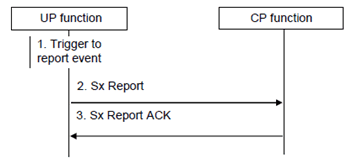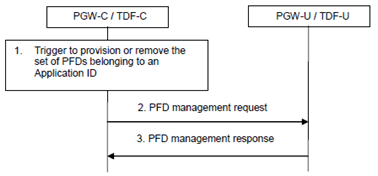Content for TS 23.214 Word version: 18.0.0
1…
4.3…
5…
5.6…
5.10…
6…
6.3…
6.3.1.2
6.3.1.3…
6.3.1.6…
6.3.2…
6.3.3…
6.3.3.4…
6.3.3.7…
6.3.4…
6.3.4.2…
6.3.4.2.2
6.3.4.3
6.4…
7…
6.4 Sx Reporting Procedures
6.4.1 General
6.4.2 Sx Session Level Reporting Procedure
6.5 Sx Management Procedures
6.5.1 General
6.5.2 Sx PFD management Procedure
6.5.3 Sx Association Setup Procedure
6.5.4 Sx Association Update Procedure
6.5.5 Sx Association Release Procedure
6.4 Sx Reporting Procedures p. 81
6.4.1 General p. 81
The Sx reporting procedure is used by the UP function of SGW, PGW or TDF to report events to the CP function.
The following Sx reporting procedures exist: Sx session level reporting and Sx node level reporting. Both are initiated by the CP function.
6.4.2 Sx Session Level Reporting Procedure p. 81
This procedure is used by the UP function to report events related to an Sx session for an individual PDN connection IP-CAN session, TDF session or TDF in unsolicited reporting mode. The triggers for event reporting were configured on the UP function during Sx session management procedures by the CP function (excluding the Sx session termination procedure).

Step 1.
The UP function detects that an event has to be reported. The reporting triggers involve the following cases:
Step 2.
- Usage report (by SGW-U, PGW-U and TDF-U). Usage information shall be collected in the UP function and reported to the CP function as defined in clause 5.3 and clause 7.4.
- Start of traffic detection (by PGW-U and TDF-U). When traffic detection is requested by PGW-C/TDF-C, and the start of traffic is detected for a PDR, the PGW-U/TDF-U shall report the start of traffic detection to the PGW-C/TDF-C and indicate the PDR rule ID.
- Stop of traffic detection (by PGW-U and TDF-U). When traffic detection is requested by PGW-C/TDF-C, and the end of traffic is detected for a PDR, the PGW-U/TDF-U shall report the stop of traffic detection to the PGW-C/TDF-C and indicate the PDR rule ID.
- Detection of 1st Downlink Data for Idle-Mode UE (by SGW-U) When SGW-U receives the downlink packet but no S1-bearer for transmission and the buffering is performed by SGW-U, it shall report the detection of 1st downlink data to SGW-C, for the purpose of paging the UE. SGW-U shall also report the DSCP of the packet when instructed by SGW-C (e.g. in case the Paging Policy Differentiation function as described in TS 23.401 is enabled at the SGW-C).
The UP function sends an Sx report message (Session ID, list of [Reporting trigger, Measurement information]) to the CP function.
The Reporting trigger parameter contains the name of the event which triggered the report and the Measurement information parameter contains the actual information the CP function requested to be informed about.
Step 3.
The CP function identifies the Sx session context based on the received Session ID and applies the reported information for the corresponding PDN connection IP-CAN session, TDF session or TDF in unsolicited reporting mode. The CP function responds with an Sx report ACK message.
6.5 Sx Management Procedures p. 82
6.5.1 General p. 82
Sx management procedures are used by the CP function to manage the UP function independent of any Sx session.
6.5.2 Sx PFD management Procedure p. 82
The Sx PFD management procedure is used by the PGW-C or TDF-C to provision or remove all PFD(s) belonging to an Application ID in the UP function as described in clause 5.11.4. PFD sets belonging to different Application IDs can be managed with the same PFD management request message.
The Sx PFD management procedure is a node level procedure, i.e. independent of any Sx session.

Step 1.
The CP function is triggered to provision or remove the PFD set belonging to an Application ID as described in clause 5.11.4.
Step 2.
The CP function sends a PFD management request message to the UP function (containing the parameters described in clause 7.9.1) to provision/remove the PFD set corresponding to the Application ID.
Step 3.
The UP function acknowledges by responding with a PFD management response message.
6.5.3 Sx Association Setup Procedure p. 83
The Sx Association Setup procedure is used to setup an association between the CP function and the UP function which enables the CP function to subsequently interact with the UP function, e.g. to establish Sx Sessions.
The setup of an Sx association may be initiated by the CP function or the UP function as described in clause 6.2.6 of TS 29.244. The CP function and the UP function shall support the Sx association setup initiated by the CP function. The CP function and the UP function may additionally support the Sx association setup initiated by the UP function.
The CP function should only establish an Sx association with a UP function that supports F-TEID allocation at the UP function.
6.5.4 Sx Association Update Procedure p. 83
The Sx Association Update procedure is used to modify an existing Sx association between the CP function and the UP function. It may be initiated by the UP function or by the CP function, as described in clause 6.2.7 of TS 29.244.
6.5.5 Sx Association Release Procedure p. 83
The Sx Association Release procedure is used to terminate the Sx association between the CP function and the UP function due to e.g. OAM reasons. The Sx Association Release procedure can be only initiated by the CP function, as described in clause 6.2.8 of TS 29.244.